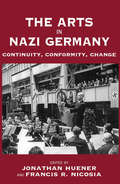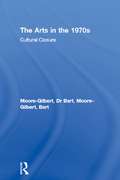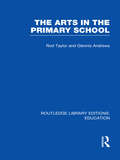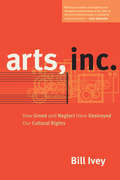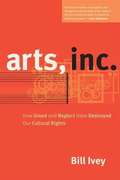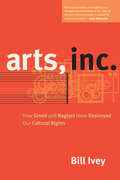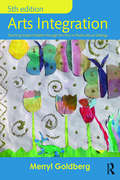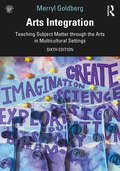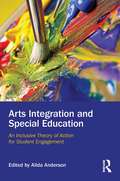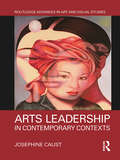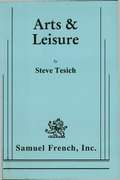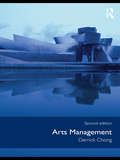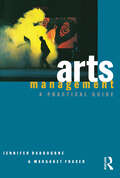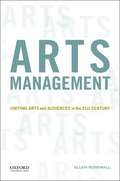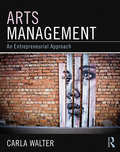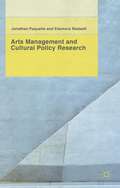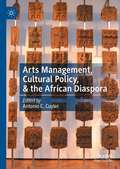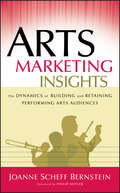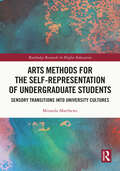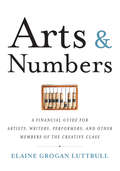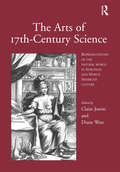- Table View
- List View
The Arts In Nazi Germany
by Francis R. Nicosia Jonathan HuenerCulture and the arts played a central role in the ideology and propaganda of National Socialism from the early years of the movement until the last months of the Third Reich in 1945. Hitler and his followers believed that art and culture were expressions of race, and that "Aryans" alone were capable of creating true art and preserving true German culture. This volume's essays explore these and other aspects of the arts and cultural life under National Socialism, and are authored by some of the most respected authorities in the field: Alan Steinweis, Michael Kater, Eric Rentschler, Pamela Potter, Frank Trommler, and Jonathan Petropoulos. The result is a volume that offers students and interested readers a brief but focused introduction to this important aspect of the history of Nazi Germany.
Arts in Place: The Arts, the Urban and Social Practice (Routledge Research in Culture, Space and Identity)
by Cara CourageThis interdisciplinary book explores the role of art in placemaking in urban environments, analysing how artists and communities use arts to improve their quality of life. It explores the concept of social practice placemaking, where artists and community members are seen as equal experts in the process. Drawing on examples of local level projects from the USA and Europe, the book explores the impact of these projects on the people involved, on their relationship to the place around them, and on city policy and planning practice. Case studies include Art Tunnel Smithfield, Dublin, an outdoor art gallery and community space in an impoverished area of the city; The Drawing Shed, London, a contemporary arts practice operating in housing estates and parks in Walthamstow; and Big Car, Indianapolis, an arts organisation operating across the whole of this Midwest city. This book offers a timely contribution, bridging the gap between cultural studies and placemaking. It will be of interest to scholars, students and practitioners working in geography, urban studies, architecture, planning, sociology, cultural studies and the arts.
The Arts in the 1970s: Cultural Closure
by Bart Moore-Gilbert Dr Bart Moore-GilbertWere the 1970s really `the devils decade'? Images of strikes, galloping inflation, rising unemployment and bitter social divisions evoke a period of unparalleled economic decline, political confrontation and social fragmentation. But how significant were the pessimism and self-doubt of the 1970s, and what was the legacy of its cultural conflicts? Covering the entire spectrum of the arts - drama, television, film, poetry, the novel, popular music, dance, cinema and the visual arts - The Arts in the 1970s challenges received perceptions of the decade as one of cultural decline. The collection breaks new ground in providing the first detailed analysis of the cultural production of the decade as a whole, providing an invaluable resource for all those involved in cultural, media and communications studies.
The Arts in the Primary School (Routledge Library Editions: Education)
by Rod Taylor Glennis AndrewsFirmly based on the authors’ personal experience, this book tackles a wide range of issues relating to the teaching of the arts in the primary school. The authors illustrate how primary children of all ages can be educated to both know about and to practice all the major art forms, and how a school staff can effectively accommodate and practice them all, even within the constraints of the National Curriculum. This book is unique in primary school education terms, as its primary focus is specific and it embraces every major art form – dance, drama, literature, music, visual arts and film.
Arts, Inc.: How Greed and Neglect Have Destroyed Our Cultural Rights
by Bill IveyIn this impassioned and persuasive book, Bill Ivey, the former chairman of the National Endowment for the Arts, assesses the current state of the arts in America and finds cause for alarm. Even as he celebrates our ever-emerging culture and the way it enriches our lives here at home while spreading the dream of democracy around the world, he points to a looming crisis. The expanding footprint of copyright, an unconstrained arts industry marketplace, and a government unwilling to engage culture as a serious arena for public policy have come together to undermine art, artistry, and cultural heritage--the expressive life of America. In eight succinct chapters, Ivey blends personal and professional memoir, policy analysis, and deeply held convictions to explore and define a coordinated vision for art, culture, and expression in American life.
Arts, Inc.: How Greed and Neglect Have Destroyed Our Cultural Rights
by Bill IveyIn this impassioned and persuasive book, Bill Ivey assesses the current state of the arts in America and finds cause for alarm. Even as he celebrates our ever-emerging culture and the way it enriches our lives here at home while spreading the dream of democracy around the world, he points to a looming crisis.
Arts, Inc.: How Greed and Neglect Have Destroyed Our Cultural Rights
by Bill IveyIn this impassioned and persuasive book, Bill Ivey, the former chairman of the National Endowment for the Arts, assesses the current state of the arts in America and finds cause for alarm. Even as he celebrates our ever-emerging culture and the way it enriches our lives here at home while spreading the dream of democracy around the world, he points to a looming crisis. The expanding footprint of copyright, an unconstrained arts industry marketplace, and a government unwilling to engage culture as a serious arena for public policy have come together to undermine art, artistry, and cultural heritage—the expressive life of America. In eight succinct chapters, Ivey blends personal and professional memoir, policy analysis, and deeply held convictions to explore and define a coordinated vision for art, culture, and expression in American life.
Arts Integration: Teaching Subject Matter through the Arts in Multicultural Settings
by Merryl GoldbergPractical and engaging, Merryl Goldberg’s popular guide to integrating the arts throughout the K-12 curriculum blends contemporary theory with classroom practice. Beyond teaching about the arts as a subject in and of itself, the text explains how teachers may integrate the arts—literary, media, visual, and performing—throughout subject area curriculum and provides a multitude of strategies and examples. Promoting ways to develop children's creativity and critical thinking while also developing communications skills and fostering collaborative opportunities, it looks at assessment and the arts, engaging English Language Learners, and using the arts to teach academic skills. This text is ideal as a primer on arts integration and a foundational support for teaching, learning, and assessment, especially within the context of multicultural and multilingual classrooms. In-depth discussions of the role of arts integration in meeting the goals of Title I programs, including academic achievement, student engagement, school climate and parental involvement, are woven throughout the text, as is the role of the arts in meeting state and federal student achievement standards. Changes in the 5th Edition: New chapter on arts as text, arts integration, and arts education and their place within the context of teaching and learning in multiple subject classrooms in multicultural and multilingual settings; Title I and arts integration (focus on student academic achievement, student engagement, school climate, and parental involvement–the 4 cornerstones of Title I); Attention to the National Core Arts Standards as well as their relationship to other standardized tests and arts integration; more (and more recent) research-based studies integrated throughout; Examples of how to plan arts integrated lessons (using backward design) along with more examples from classrooms’; Updated references, examples, and lesson plans/units; Companion Website: www.routledge.com/cw/goldberg
Arts Integration: Teaching Subject Matter through the Arts in Multicultural Settings
by Merryl GoldbergNow in its sixth edition, Merryl Goldberg’s popular volume Arts Integration presents a comprehensive guide to integrating the arts throughout the K-12 curriculum, blending contemporary theory with classroom practice. Beyond teaching about arts education as a subject in and of itself, the text explains how teachers may integrate the arts—literary, media, visual, and performing—throughout the subject curriculum, offering a wealth of strategies, techniques, and examples. Promoting ways to develop children’s creativity and critical thinking while also developing communications skills and fostering collaboration and community activism, Arts Integration explores assessment and the arts, engaging English Language Learners, and using the arts to teach academic skills in science, math, history, and more. This text is ideal as a primer on arts integration and a foundational support for teaching, learning, and assessment, especially within the context of multicultural and multilingual classrooms. In-depth discussions of the role of arts integration in meeting the goals of Title I programs, including academic achievement, student engagement, school climate, and parental involvement, are woven throughout the text, as is the role of the arts in nurturing Creative Youth Development work and its importance to the community. This revised and updated sixth edition combines a social justice emphasis with templates for developing lesson plans and units, updated coverage on STEAM education, along with brand new examples, case studies, and research. An expanded range of eResources is also available for this edition, including links to further resources readings, additional imagery and videos, and sample lesson plans.
Arts Integration and Special Education: An Inclusive Theory of Action for Student Engagement
by Alida AndersonArts Integration and Special Education contributes to research, policy, and practice by providing a theory of action for studying how linguistic, cognitive, and affective student engagement relates to arts integrated learning contexts and how these dimensions of engagement influence content area and literacy learning. Arts Integration and Special Education connects the interdisciplinary framework in human development and linguistics, special education, and urban education with primary action research by special educators trained in arts integration, working in an inclusive urban charter school with middle school age students. Upper elementary to middle-grade level student learning is relatively understudied and this work contributes across fields of special education and urban education, as well as arts education. Moreover, the classrooms in which the action research occurs are comprised of students with a diverse range of abilities and needs. The book’s interdisciplinary model, which draws on developmental and educational psychology, special education, and speech/language pathology research and practice, is the first to posit explanations for how and why AI contexts facilitate learning in students with language and sensory processing disorders, and those at-risk for school failure due to low socioeconomic status conditions.
Arts Leadership: Creating Sustainable Arts Organizations (Mastering Management in the Creative and Cultural Industries)
by Kenneth FosterThe contemporary world faces unprecedented upheaval and change forcing institutions of all types to rethink how they are designed and how they must now function if they are to survive into an uncertain future. The performing arts are no exception; in an era of constant change and technological transformation, arts organizations and their leaders face significant organizational challenges if they are to maintain their relevance. Arts Leadership: Creating Sustainable Arts Organizations provides a contemporary overview of the field of arts leadership, focused on the performing arts. It examines what these challenges are, how they are affecting the performing arts and arts organizations in general and proposes creative ways to reimagine, build and lead sustainable arts organizations in this uncharted environment. With a global perspective drawn from his extensive experience advising arts organizations around the world and based on his own work successfully leading important performing arts organizations in the United States, Foster proposes an innovative approach to organizational design, systems, and structures for arts leaders in the 21st century that is based in ecological thinking and the creative process that is intrinsic to the arts. In disrupting conventional arts leadership practice, the book provides an exceptional tool to understand a unique sector, and is essential reading for students and practitioners across the creative and cultural industries.
Arts Leadership in Contemporary Contexts (Routledge Advances in Art and Visual Studies)
by Josephine CaustThis book explores and critiques different aspects of arts leadership within contemporary contexts. While this is an exploration of ways arts leadership is understood, interpreted and practiced, it is also an acknowledgement of a changing cultural and economic paradigm. Understanding the broader environment for the arts is therefore part of the leadership imperative. This book examines aspects such as individual versus collective leadership, gender, creativity and the influences of stakeholders and culture. While the book provides a theoretical and critical understanding of arts leadership, it also gives examples of arts leadership in practice.
Arts & Leisure
by Steve TesichWritten by the popular author of On the Open Road and other works, this brilliantly caustic play is built around a self absorbed drama critic who judges theatre and life by the same criteria, to absurd extremes. He is confronted by the bitter, alienated women who have suffered from his unyielding clinical detachment and his determination to judge suffering, global and personal, by its dramatic impact on him. These include his ex wife, a former actress who is losing her grip; his tragic daughter, a stand up comedienne; his forlornly empathetic old mother and his acrimonious housekeeper and confidante. The critic longs for human contact but conducts his life as a series of pat scenes that avoid the messy and tangled issues of real relationships. FEE: $75 per performance.
Arts Management
by Derrick ChongThe second edition of Arts Management has been thoroughly revised to provide an updated, comprehensive overview of this fast-changing subject. Arts managers and students alike are offered a lively, sophisticated insight into the artistic, managerial and social responsibilities necessary for those working in the field. With new cases studies and several new chapters, Derrick Chong takes an interdisciplinary approach in examining some of the main impulses informing discussions on the management of arts and cultural organizations. These are highly charged debates, since arts managers are expected to reconcile managerial, economic and aesthetic objectives. Topics include: arts and the State, with reference to the instrumentalism of the arts and culture business and the arts ownership and control of arts organizations arts consumption and consumers, including audience development and arts marketing managing for excellence and artistic integrity financial investing in the arts, namely fine arts funds and theatre angels philosophies of philanthropy Incorporating a deliberately diverse range of sources, Arts Management is essential reading for students on arts management courses and provides valuable insights for managers already facing the management challenges of this field.
Arts Management: A practical guide
by Jennifer RadbourneArts management is no longer a resting place for enthusiastic amateurs or artists with insufficient talent to make the big time. Rather, it is increasingly being recognised as a profession with a set of skills which need to be learnt.Arts Management is a comprehensive handbook for arts administrators working in all art forms and in organisations ranging from small community co-operatives to large national flagships. With extensive Australian case studies, it covers cultural policy, fundraising, legal issues, marketing and public relations, managing people and money and event management.Arts Management is an essential reference for practising arts administrators and students.
Arts Management: Uniting Arts And Audiences In The 21st Century
by Ellen RosewallDesigned for students and practitioners with little experience in not-for-profit management, Arts Management provides an indispensable guide to the theory and practice of managing arts and cultural organizations. This concise text engages readers with case studies and critical-thinking exercises that will develop their ability to adapt to a changing industry. From governance and human resources to program development, financial management, and marketing, Arts Management addresses the unique atmosphere of managing the arts today. It meets the standards of the AAAE (Association of Arts Administration Educators) guaranteeing that both current and future practitioners will be prepared to meet the challenges of managing today's arts organizations.
Arts Management: An entrepreneurial approach
by Carla WalterArts Management is designed as an upper division undergraduate and graduate level text that covers the principles of arts management. It is the most comprehensive, up to date, and technologically advanced textbook on arts management on the market. While the book does include the background necessary for understanding the global arts marketplace, it assumes that cultural fine arts come to fruition through entrepreneurial processes, and that cultural fine arts organizations have to be entrepreneurial to thrive. Many cases and examples of successful arts organizations from the Unites States and abroad appear in every chapter. A singular strength of Arts Management is the author's skilful use of in-text tools to facilitate reader interest and engagement. These include learning objectives, chapter summaries, discussion questions and exercises, case studies, and numerous examples and cultural spotlights. Online instructor's materials with PowerPoints are available to adopters.
Arts Management and Cultural Policy Research
by Jonathan Paquette Eleonora RedaelliPresenting concepts, knowledge and institutional settings of arts management and cultural policy research, this book builds on two assumptions that are simultaneously propositions. The first is that arts management research and cultural policy research evolve in an academic space that is very loosely connected, but nevertheless federated. The second is that we evolve in a field where there is a greater diversity of knowledge producers than it is often assumed. Practicing outside academia, many arts managers, policymakers, advocates, and other professionals still connect and mediate knowledge in spaces that are interconnected, and perhaps even more integrated than we would readily admit. This book offers a map, a representation of the concepts and spaces of knowledge production in the field. It constitutes an excellent introduction to students, and scholars and practitioners will find in it a renewed representation of the field and the seeds of an intellectual debate on our research community.
Arts Management, Cultural Policy, & the African Diaspora
by Antonio C. CuylerThis book centers people of African descent as cultural leaders to challenge the myth that they do not know how or care about managing and preserving their culture. Arts Management, Cultural Policy, & the African Diaspora also presents comparative case studies of the challenges, differences, similarities, and successes in approaches to cultural leadership across multiple cultural contexts throughout the diaspora. This volume disrupts the enduring and systemic global marginalization, oppression, and subjugation that threatens and undermines people of African descent’s cultural contributions to humanity. The most important distinguishing feature of the volume is its geographical use of the African diaspora to explore the subjects of arts management and cultural policy which, to date, no volume has done before. Furthermore, the volume’s comparative examination of ten critical, historical, practical, and theoretical questions makes it a significant contribution to the literatures in Arts Management, Cultural Policy, Cultural, Africana, African American, and Ethnic studies.
The Arts Management Handbook: New Directions for Students and Practitioners
by Constance DeVereaux Meg BrindleWhether the art form is theater, dance, music, festival, or the visual arts and galleries, the arts manager is the liaison between the artists and their audience. Bringing together the insights of educators and practitioners, this groundbreaker links the fields of management and organizational management with the ongoing evolution in arts management education. It especially focuses on the new directions in arts management as education and practice merge. It uses cases studies as both a pedagogical tool and an integrating device. Separate sections cover Performing and Visual Arts Management, Arts Management Education and Careers, and Arts Management: Government, Nonprofits, and Evaluation. The book also includes a chapter on grants and raising money in the arts.
Arts Marketing
by Finola Kerrigan Peter Fraser Mustafa OzbilginArts Marketing focuses on a variety of sectors within the arts and addresses the way in which marketing principles are applied within these, outlining both the similarities and the differences that occur. Relating policy to practice, this contributed text demonstrates the most effective means of marketing in specific areas of the arts, with each chapter having been written by a specialist in the field. Although primarily focusing on the UK market, the subject has global relevance and appeal, and policy is evaluated on national, European and supranational levels. Specialist topics dealt with range from the marketing of the theatre, opera, and museums, through to the film industry and popular music.
Arts Marketing Insights
by Joanne Scheff Bernstein Philip KotlerAudience behavior began to shift dramatically in the mid 1990s. Since then, people have become more spontaneous in purchasing tickets and increasingly prefer selecting specific programs to attend rather than buying a subscription series. Arts attenders also expect more responsive customer service than ever before. Because of these and other factors, many audience development strategies that sustained nonprofit arts organizations in the past are no longer dependable and performing arts marketers face many new challenges in their efforts to build and retain their audiences. Arts organizations must learn how to be relevant to the changing lifestyles, needs, interests, and preferences of their current and potential audiences.Arts Marketing Insights offers managers, board members, professors, and students of arts management the ideas and information they need to market effectively and efficiently to customers today and into the future. In this book, Joanne Scheff Bernstein helps readers to understand performing arts audiences, conduct research, and provide excellent customer service. She demonstrates that arts organizations can benefit by expanding the meaning of "valuable customer" to include single-ticket buyers. She offers guidance on long-range marketing planning and helps readers understand how to leverage the Internet and e-mail as powerful marketing channels. Bernstein presents vivid case studies and examples that illustrate her strategic principles in action from organizations large and small in the United States, Great Britain, Australia, and other countries.
Arts Methods for the Self-Representation of Undergraduate Students: Sensory Transitions into University Cultures (Routledge Research in Higher Education)
by Miranda MatthewsThis timely book explores the transitional experiences of undergraduates in minority groups studying at university and how arts methods and practices can play an important role in facilitating these transitions. Based on research from UK universities, this volume is the first to draw together the experiences of educators in the humanities and social sciences who integrate sensory methodologies in taught curriculum, in relation to arts educators who add extra-curricular arts practice. It offers an original, contextualised analysis of how to enable university structures to adapt to complexity, difference, and diversity, taking the view that arts practice forms meeting points for confident interconnection and spaces of self-representation. It outlines the novel concept of sensory transition in how arts practices can be used to address issues of inclusion, diversity, and self-representation for minority groups. Each chapter offers an in-depth analysis of significant issues, such as dimensions of race, gender, and class and the specificities of social and cultural group experiences as they occur in arts practice. The book reflects on the decolonisation of university structures and curriculum and demonstrates how universities can support students and build spaces for self-representation in academic courses. Accessible and investigative, this book is essential reading for academics, researchers, and postgraduate students in the field of higher education, inclusion, and arts methods. It will also be of great interest to higher education staff interested in decolonisation, diversity, and university futures.
Arts & Numbers
by Elaine Grogan LuttrullThe creative class-artists, actors, writers, musicians, freelancers, dancers, performers, and the like-are known for applying their passion for creative expression to everything they do. Perhaps the one thing that most fills this group with apprehension is the rigid world of numbers. This leads to problems arising from the unconventional financial and business situations of creative professionals, as well as the nonprofit organizations with which they're often affiliated. Finances, budgeting, and business matters can be dreaded, if not outright ignored, by creatives--to the detriment of their artistic pursuits.Author, artist, and CPA Elaine Grogan Luttrull has written Arts & Numbers to help creative professionals find the same confidence in their financial dealings as in their chosen mode of expression. It is an engaging, accessible guide that covers a variety of must-know topics, such as budgeting, cash management, visual charting, taxes, employment, and business etiquette. In a simple, straightforward style, Luttrull draws examples from smooth-flowing narratives depicting common issues within the arts worlds, as well as from her own personal anecdotes. Unlike stuffy textbooks and patronizing business books, Arts & Numbers is a lively and artfully done ally in helping creative professionals plan their present financial situations and secure their futures.
The Arts of 17th-Century Science: Representations of the Natural World in European and North American Culture
by Claire Jowitt Diane WattContemporary ideals of science representing disinterested and objective fields of investigation have their origins in the seventeenth century. However, 'new science' did not simply or uniformly replace earlier beliefs about the workings of the natural world, but entered into competition with them. It is this complex process of competition and negotiation concerning ways of seeing the natural world that is charted by the essays in this book. The collection traces the many overlaps between 'literary' and 'scientific' discourses as writers in this period attempted both to understand imaginatively and empirically the workings of the natural world, and shows that a discrete separation between such discourses and spheres is untenable. The collection is designed around four main themes-'Philosophy, Thought and Natural Knowledge', 'Religion, Politics and the Natural World', 'Gender, Sexuality and Scientific Thought' and 'New Worlds and New Philosophies.' Within these themes, the contributors focus on the contests between different ways of seeing and understanding the natural world in a wide range of writings from the period: in poetry and art, in political texts, in descriptions of real and imagined colonial landscapes, as well as in more obviously 'scientific' documents.
